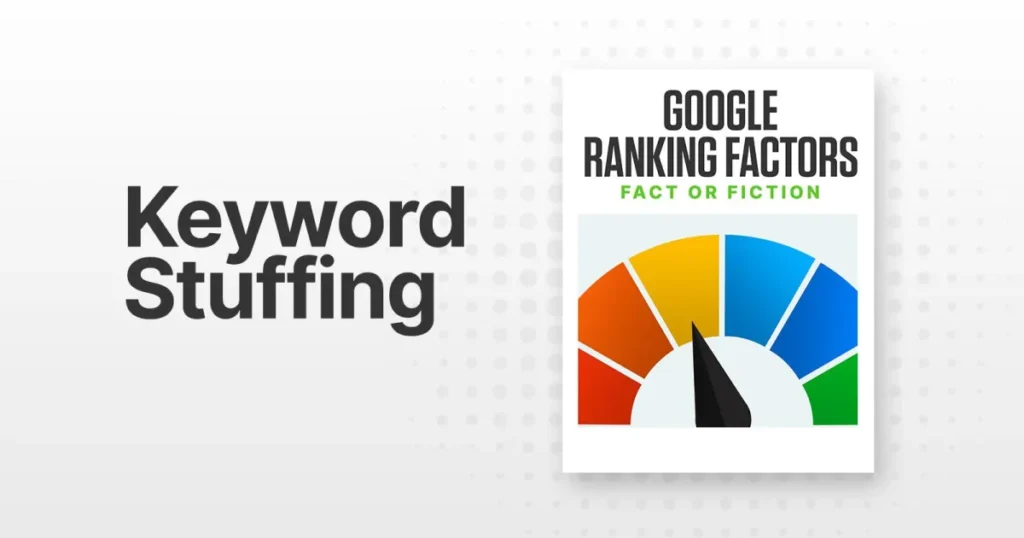
Keyword stuffing was once a popular tactic because it delivered results, at least for a while. But how does Google view it now?
The Simple Logic Behind Keyword Stuffing:
If some keywords are good, then more must be better, right? This straightforward logic drove the use of keyword stuffing as a ranking factor.
In the early days of web search, long before SEO became a recognized field, Google ranked web content using a basic set of signals. Keywords were one of those signals. The more keywords you used, the better a page would rank, especially in the early days of search engines.
Keyword stuffing became a widely adopted technique because it was effective, at least for a period. But how does Google handle it now?
The Claim: Keyword Stuffing Is a Ranking Factor
Exact match keywords once carried significant weight. If a keyword appeared on a page exactly as the user typed it, the page had a high chance of ranking.
Once people realized they could rank their websites for more queries by repeating different variations of keywords on a page, the practice of keyword stuffing emerged.
You could go to great lengths with keyword stuffing, from overusing keywords in on-page copy to entire paragraphs filled with keywords separated by commas.
An even more blatant form of keyword stuffing involved hiding paragraphs of keywords by making the text the same color as the page’s background. Google could detect hidden keywords when crawling the pages, but users wouldn’t notice anything unusual.
Keyword stuffing wasn’t confined to on-page copy. Page titles and meta descriptions were also packed with keywords in an attempt to manipulate search rankings.
When people refer to the early days of SEO as being like the Wild West, this is what they mean. Not only were sites not penalized for keyword stuffing, but they were also more likely to benefit from it.
The Impact of Google’s Algorithm Updates
The influence of keyword stuffing on search rankings began to shift in 2003 with the Florida update, considered Google’s first major algorithm update.
Evidence indicates that the Florida update primarily targeted link spam, but sites using other spammy techniques were affected as well.
While the Florida update reduced the impact of keyword stuffing to some degree, it didn’t completely eliminate its rewards in Google’s algorithms.
In 2011, Google launched the Panda update, which targeted low-quality sites and thin content with little or no added value.
This led to keyword-stuffed pages being demoted in search results, as those pages typically offered less value compared to pages not designed to manipulate search engines.
Following Panda, Google strongly advised against keyword stuffing.
Finally, we can’t discuss the evolution of keywords in SEO without mentioning Google’s Hummingbird update in 2013.
Hummingbird introduced conversational search to Google, allowing users to type queries using natural language, and Google’s algorithm would understand their intent.
Content writing approaches evolved after this update, especially regarding the unnatural use of keywords. It’s fair to say that Hummingbird sparked the shift from writing content for search engines to writing content for people.
Keyword stuffing was done purely to manipulate rankings and didn’t add any value for searchers. It’s now an outdated technique, as Google’s search algorithm has become more adept at recognizing quality content.
The Evidence Against Keyword Stuffing as a Ranking Factor
There’s evidence across Google’s search results that keyword stuffing is no longer a ranking factor.
Today’s SERPs feature page titles that read naturally, meta descriptions containing actual copy, and articles free from excessive exact-match phrases.
But that’s anecdotal evidence. Let’s examine the hard evidence directly from the source.
Google’s Webmaster Guidelines, which websites must follow to remain indexed in search, address keyword stuffing in a section titled “irrelevant keywords.”
It states:
“‘Keyword stuffing’ refers to the practice of loading a webpage with keywords or numbers in an attempt to manipulate a site’s ranking in Google search results. Often these keywords appear in a list or group, or out of context (not as natural prose). Filling pages with keywords or numbers results in a negative user experience and can harm your site’s ranking. Focus on creating useful, information-rich content that uses keywords appropriately and in context.”
If there was any doubt that Google demotes pages filled with an unnecessary number of keywords, there’s your official confirmation right in the Webmaster Guidelines.
The Verdict: Keyword Stuffing as a Ranking Factor

Keyword stuffing is a confirmed negative ranking factor.
Attempting to manipulate search rankings by repeatedly using words or phrases will only cause a site to rank lower in Google’s search results. Be cautious of any advice suggesting otherwise.
More Resources:
- How To Identify & Eliminate Keyword Cannibalization To Boost Your SEO
- Your Essential Guide to Internal Content Linking
